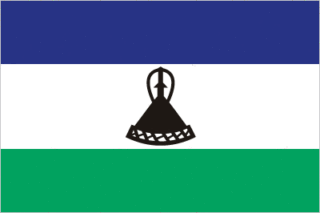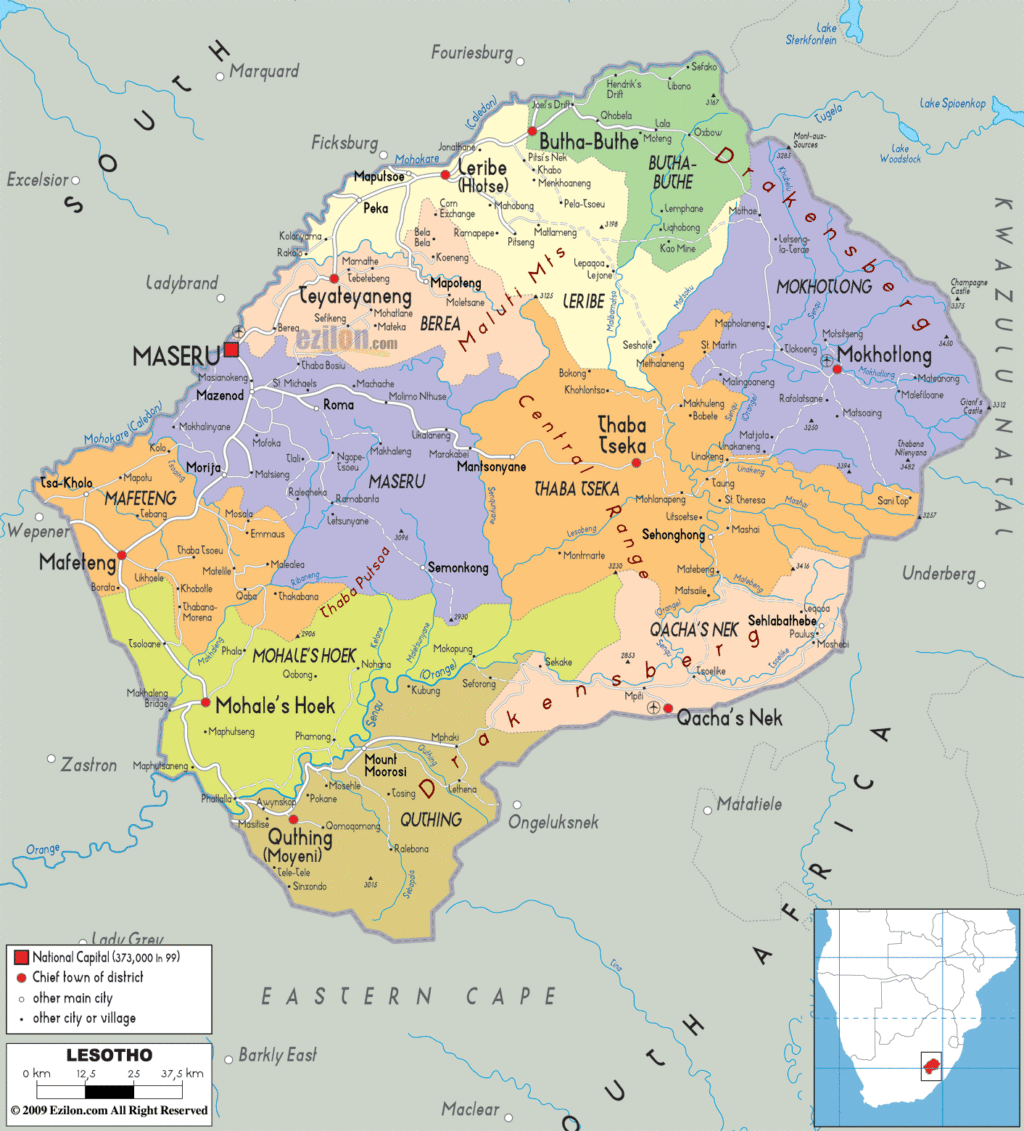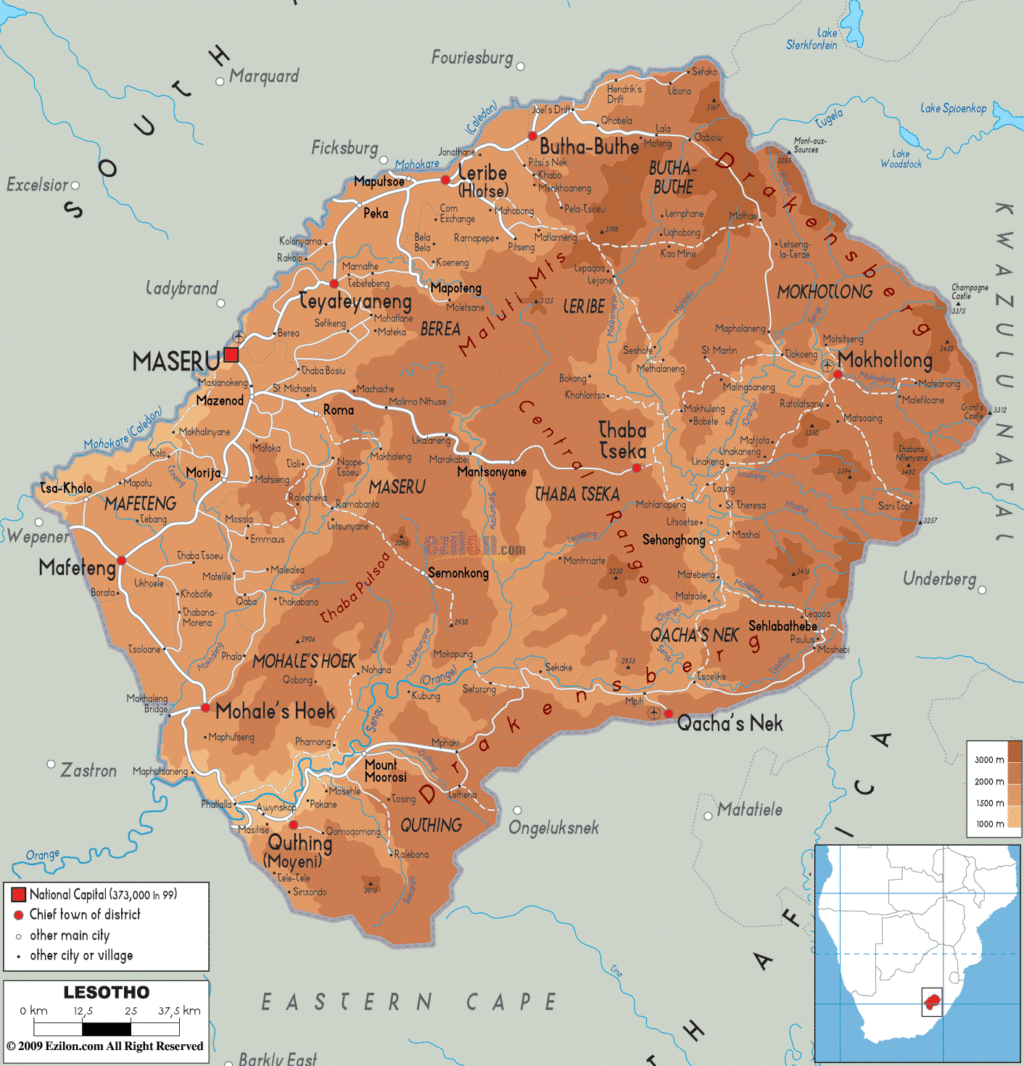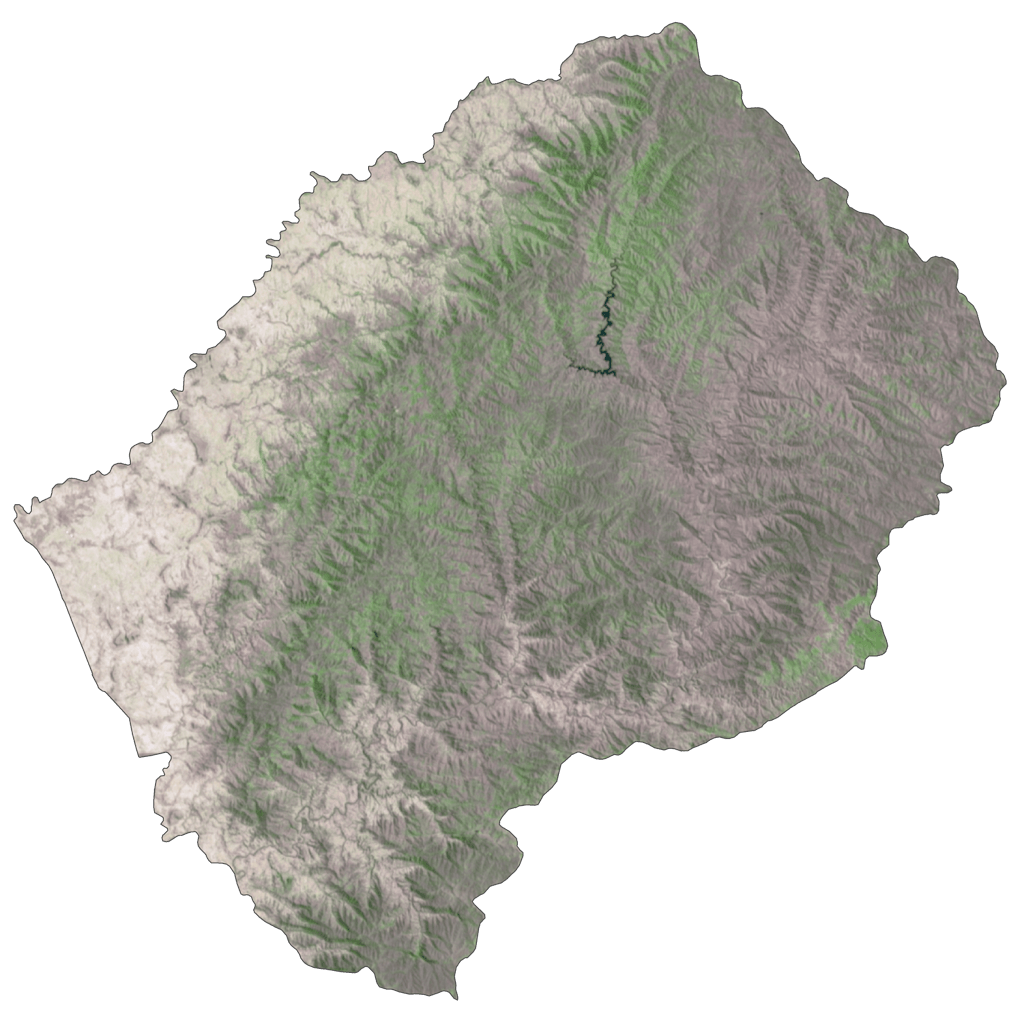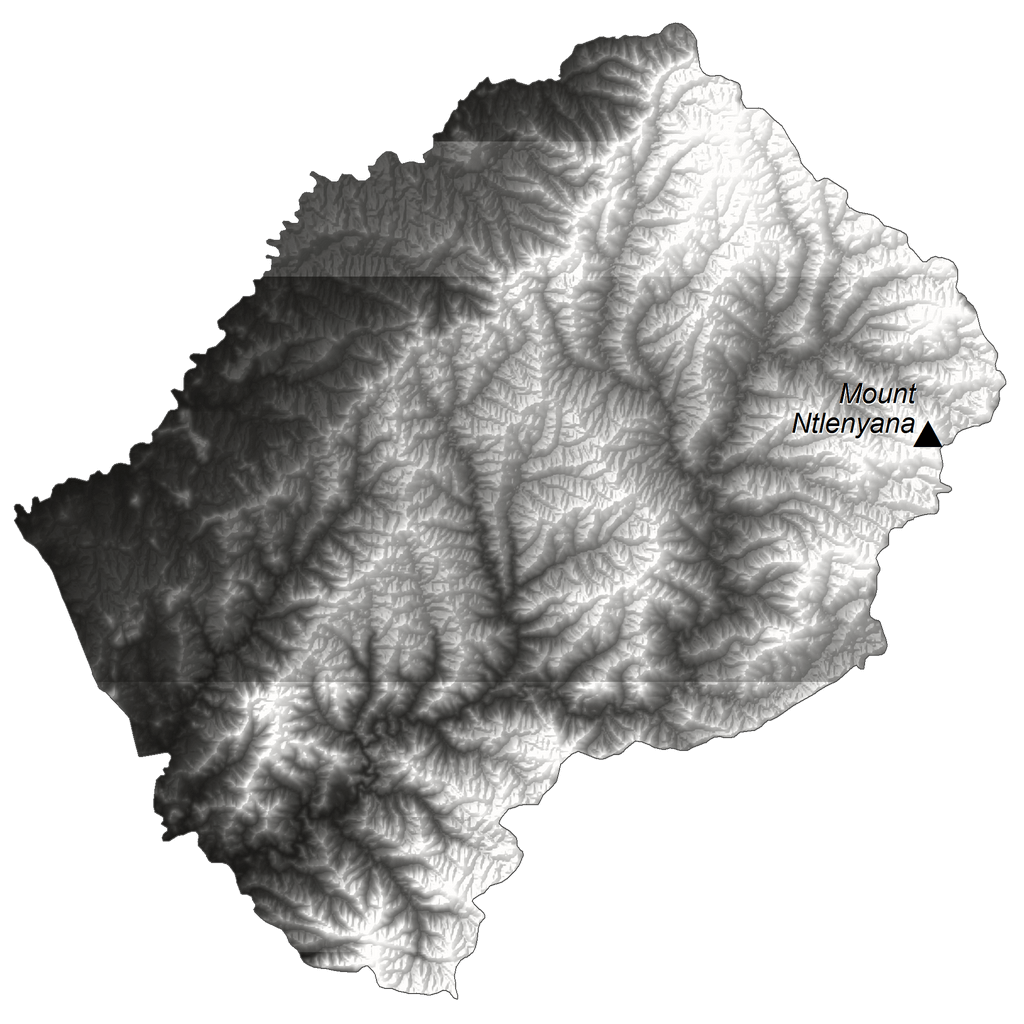Lesotho is an enclave as it is surrounded by South Africa in Southern Africa. The country has an area of 30,000 sq. km.
Lesotho is also unique in other ways. It is the only independent state in the world that lies entirely above 1,400 m in elevation. In fact, 80% of the country lies above 1,800 m. Its lowest point (marked on the map by an inverted yellow triangle) of 1,400 m is thus the highest (lowest point) in the world.
Thabana Ntlenyana is the highest point of Lesotho at 3,482 m (marked on the map by an upright yellow triangle)
As for geographic regions in Lesotho, the only real lowlands are in the southwest along the Caledon River. The balance of Lesotho is a series of foothills and plateaus fronting mountains, central, east and north.Significant rivers include the Calendon, Makhaleng, Malibamatso, Matsoku and Orange (or Senqu). The Orange River at about 2,100 km in length is one of the longest rivers in Africa. It rises in the Lesotho Highlands as the Sinqu River. In South Africa it flows west, passing the southern edge of the Kalahari Desert and winds through the Namib Desert before draining into the Atlantic Ocean.
Lesotho, the small landlocked country in Southern Africa, is a land of extremes. The country is entirely surrounded by the Republic of South Africa and is home to some of the highest peaks in the world. Its terrain is extremely rugged and mountainous, and this map of Lesotho showcases its stunning beauty.
The map of Lesotho includes cities, roads, lakes, rivers, and mountains. Its satellite imagery and elevation map help to illustrate its dramatic landscape. Lesotho is home to some of the world’s highest peaks, such as Thabana Ntlenyana, which stands at 3,482 meters above sea level. The country also has numerous glacial lakes, such as the Katse Dam, the largest dam in Lesotho.
For those looking to explore this beautiful country, the map of Lesotho is a great starting point. It will help you plan your journey, from navigating its winding roads to finding the best places to take in the breathtaking views. Whether you’re looking to explore the majestic mountains or take a dip in the crystal-clear lakes, Lesotho has something for everyone.
Online Interactive Political Map
Click on ![]() to view map in "full screen" mode.
to view map in "full screen" mode.
Lesotho has 10 districts, each with a capital called camptown. The districts are subdivided into 80 constituencies and 129 local community councils.
In alphabetical order, the districts are as follows: Berea, Butha-Buthe, Leribe, Mafeteng, Maseru, Mohale’s Hoek, Mokhotlong, Qacha’s Nek, Quthing, Thaba-Tseka
With an area of 4,279 sq. km, Maseru is the largest district and the most populous one as well. The capital of the district is also called Maseru and is the national capital as well.
Location Maps
Where is Lesotho?
Lesotho is a small country completely surrounded by South Africa. It is the largest independent enclave state, within another country, with the other two being Vatican City and San Marino. It is also the southernmost landlocked country in the world. Lesotho has a population of about 2 million people, and Maseru is the capital and largest city. The two official languages of Lesotho are Sesotho and English.
High Definition Political Map of Lesotho

History
Basutoland
Basutoland emerged as a single polity under King Moshoeshoe I in 1822. Moshoeshoe, a son of Mokhachane, a minor chief of the Bakoteli lineage, formed his own clan and became a chief around 1804. Between 1820 and 1823, he and his followers settled at the Butha-Buthe Mountain, joining with former adversaries in resistance against the Lifaqane associated with the reign of Shaka Zulu from 1818 to 1828.
Further evolution of the state emerged from conflicts between British and Dutch colonists leaving the Cape Colony following its seizure from the French-allied Dutch by the British in 1795, and also from the Orange River Sovereignty and subsequent Orange Free State. Missionaries Thomas Arbousset, Eugène Casalis and Constant Gosselin from the Paris Evangelical Missionary Society, invited by Moshoeshoe I, were placed at Morija, developing Sesotho orthography and printed works in the Sesotho language between 1837 and 1855. Casalis, acting as translator and providing advice on foreign affairs, helped set up diplomatic channels and acquire guns for use against the encroaching Europeans and the Griqua people.
Trekboers from Cape Colony arrived on the western borders of Basutoland and claimed rights to its land, the first of which being Jan de Winnaar who settled in the Matlakeng area in 1838. Incoming Boers attempted to colonise the land between the two rivers and north of the Caledon, claiming that it had been abandoned by the Sotho people. Moshoeshoe subsequently signed a treaty with the British Governor of the Cape Colony, Sir George Thomas Napier, that annexed the Orange River Sovereignty where Boers had settled. These outraged Boers were suppressed in a skirmish in 1848. In 1851, a British force was defeated by the Basotho army at Kolonyama. After repelling another British attack in 1852, Moshoeshoe sent an appeal to the British commander that settled the dispute diplomatically, and then defeated the Batlokoa in 1853. In 1854, the British pulled out of the region, and in 1858, Moshoeshoe fought a series of wars with the Boers in what is known as the Free State–Basotho War. As a result, Moshoeshoe lost a portion of the western lowlands. The last war with the Boers ended in 1867 when Moshoeshoe appealed to Queen Victoria who agreed to make Basutoland a British protectorate in 1868.
In 1869, the British signed a treaty at Aliwal North with the Boers that defined the boundaries of Basutoland. This treaty reduced Moshoeshoe’s kingdom to half its previous size by ceding the western territories. Then, the British transferred functions from Moshoeshoe’s capital in Thaba Bosiu to a police camp on the northwest border, Maseru, until eventually the administration of Basutoland was transferred to the Cape Colony in 1871. Moshoeshoe died on 11 March 1870, marking the beginning of the colonial era of Basutoland. In the Cape Colony period between 1871 and 1884, Basutoland was treated similarly to other territories that had been forcibly annexed, much to the humiliation of the Basotho, leading to the Basuto Gun War in 1880–1881. In 1884, the territory became a Crown colony by the name of Basutoland, with Maseru as its capital. It remained under direct rule by a governor, while effective internal power was wielded by tribal chiefs. In 1905, a railway line was built to connect Maseru to the railway network of South Africa.
Independence
Basutoland gained its independence from the United Kingdom and became the Kingdom of Lesotho in 1966. The Basotho National Party (BNP) ruled from 1966 until January 1970. What later ensued was a de facto government led by Leabua Jonathan until 1986 when a military coup forced it out of office.
In January 1970, the ruling BNP lost the first post-independence general elections, with 23 seats to the Basotho Congress Party’s (BCP) 36. Prime Minister Jonathan refused to cede power to BCP, instead declaring himself prime minister and imprisoning the BCP leadership. BCP began a rebellion and then received training in Libya for its Lesotho Liberation Army (LLA) under the pretense of being Azanian People’s Liberation Army soldiers of the Pan Africanist Congress (PAC). Deprived of arms and supplies by the David Sibeko faction of PAC in 1978, the 178-strong LLA was rescued from their Tanzanian base by the financial assistance of a Maoist PAC officer and launched a guerrilla war. A force was defeated in northern Lesotho, and later guerrillas launched more sporadic attacks. The campaign was compromised when BCP’s leader, Ntsu Mokhehle, went to Pretoria. In the 1980s, some Basotho who sympathised with the exiled BCP were threatened with death and attacked by the government of Leabua Jonathan. On 4 September 1981, the family of Benjamin Masilo was attacked. In the attack his 3-year-old grandson died. Four days later, Edgar Mahlomola Motuba, the editor of the newspaper Leselinyana la Lesotho, was abducted from his home, together with two friends, and murdered.
The Transitional Military Council that came to power granted executive powers to King Moshoeshoe II, who was until then a ceremonial monarch. In 1987 the king was forced into exile after coming up with a 6-page memorandum on how he wanted the Lesotho’s constitution to be, which would have given him more executive powers than the military government had originally agreed to. His son was installed as King Letsie III in his place.
The chairman of the military junta, Major General Justin Metsing Lekhanya, was ousted in 1991 and replaced by Major General Elias Phisoana Ramaema who handed over power to a democratically elected government of BCP in 1993. Moshoeshoe II returned from exile in 1992 as an ordinary citizen. After the return to democratic government, King Letsie III tried unsuccessfully to persuade the BCP government to reinstate his father (Moshoeshoe II) as head of state. In August 1994, Letsie III staged a military-backed coup that deposed the BCP government, after the BCP government refused to reinstate his father, Moshoeshoe II, according to Lesotho’s constitution. Member states of the Southern African Development Community (SADC) engaged in negotiations to reinstate the BCP government. One of the conditions Letsie III put forward for this was that his father should be re-installed as head of state. After protracted negotiations, the BCP government was reinstated and Letsie III abdicated in favour of his father in 1995, and ascended the throne again when Moshoeshoe II died at the age of 57 in a supposed road accident when his car plunged off a mountain road on 15 January 1996. According to a government statement, Moshoeshoe had set out at 1 am to visit his cattle at Matsieng and was returning to Maseru through the Maluti Mountains when his car left the road.
In 1997, the ruling BCP split over leadership disputes. Prime Minister Ntsu Mokhehle formed a new party, the Lesotho Congress for Democracy (LCD), and was followed by a majority of members of parliament, which enabled him to form a new government. Pakalitha Mosisili succeeded Mokhehle as party leader and LCD won the general elections in 1998. Opposition protests “intensified”, culminating in a demonstration outside the royal palace in August 1998. While the Botswana Defence Force troops were welcomed, tensions with South African National Defence Force troops resulted in fighting. Incidences of rioting “intensified” when South African troops hoisted a South African flag over the Royal Palace. By the time the SADC forces withdrew in May 1999, much of the capital of Maseru “lay in ruins”, and the southern provincial capital towns of Mafeteng and Mohale’s Hoek had lost over a third of their commercial real estate.
An Interim Political Authority (IPA), charged with reviewing the electoral structure in the country, was created in December 1998. IPA devised a proportional electoral system to ensure that the opposition would be represented in the National Assembly. The new system retained the existing 80 elected Assembly seats, and added 40 seats to be filled on a proportional basis. Elections were held under this new system in May 2002, and LCD won, gaining 54% of the vote. There are irregularities and threats of violence from Major General Lekhanya. Nine opposition parties hold all 40 of the proportional seats, with BNP having the largest share (21). LCD has 79 of the 80 constituency-based seats. While its elected members participate in the National Assembly, BNP has launched legal challenges to the elections, including a recount.
On 30 August 2014, an alleged abortive military “coup” took place, forcing then Prime Minister Thomas Thabane to flee to South Africa for three days. On 19 May 2020, Thomas Thabane formally stepped down as prime minister of Lesotho following months of pressure after he was named as a suspect in the murder of his ex-wife. Moeketsi Majoro, the economist and former Minister of Development Planning, was elected as Thabane’s successor.
On 13 May 2020, according to the health ministry, Lesotho became the last African nation to report a COVID-19 case.
On 28 October 2022, Sam Matekane was sworn in as Lesotho’s new Prime Minister after forming a new coalition government. His Revolution for Prosperity party, formed earlier same year, won the 7 October elections.
Physical Map of Lesotho

Geography
Lesotho covers 30,355 km (11,720 sq mi). It is the only independent state in the world that lies entirely above 1,000 metres (3,281 ft) in elevation. Its lowest point of 1,400 metres (4,593 ft) is thus the highest lowest point of any country in the world. Over 80% of the country lies above 1,800 metres (5,906 ft). Lesotho is the southernmost landlocked country in the world. It is the largest of the world’s three independent states completely surrounded by the territory of another country, with Vatican City and San Marino being the other two. It is the only such state outside the Italian peninsula, and the only one that is not a microstate.
Lesotho lies between latitudes 28° and 31°S, and longitudes 27° and 30°E. About 12% of Lesotho is arable land which is vulnerable to soil erosion; it is estimated that 40 million tons of soil are lost each year due to erosion.
Climate
Because of its elevation, Lesotho remains cooler throughout the year than other regions at the same latitude. Most of the rain falls as summer thunderstorms. Maseru and surrounding lowlands may reach 30 °C (86 °F) in summer. The temperature in the lowlands can get down to −7 °C (19 °F) and the highlands to −18 °C (0 °F) at times. Snow is more common in the highlands between May and September; the higher peaks may experience snowfalls year-round. Rainfall in Lesotho is variable regarding both when and where precipitation occurs. Annual precipitation can vary from 500mm annually in one area to 1200mm in another because of elevation. The summer season that stretches from October to April sees the most rainfall, and from December to February, the majority of the country receives over 100mm of rain a month. The least monthly rainfall in Lesotho occurs in June when most regions receive less than 15mm a month.
Drought
Periodic droughts have an effect on Lesotho’s majority rural population as some people living outside of urban areas rely on subsistence farming or small scale agriculture as their primary source of income. Droughts in Lesotho are exacerbated by some agricultural practices. The World Factbook lists periodic droughts under the ‘Natural Hazard’ section of Lesotho’s section of the publication.
In 2007, Lesotho experienced a drought and was advised by the United Nations to declare a state of emergency to get aid from international organizations. Famine Early Warning Systems Network reported that the rainy season of 2018/2019 not only started a month later than normal but also has recorded below-average amounts of rain. Data from the Climate Hazards Group InfraRed Precipitation Station (CHIRP) shows rainfall in Lesotho between October 2018 and February 2019 ranged from 55% to 80% below normal rates.
In March 2019, the Lesotho Vulnerability Assessment and Analysis Committee conducted a report that initially predicted that 487,857 people in the country need humanitarian assistance because of the effects of drought.
There are a variety of different ways drought in Lesotho has led to the need for humanitarian assistance. Some hygiene practices that result from “a lack of clean water” can cause cases of typhoid and diarrhea. Lack of available water indirectly leads to an “increased risk” for women and girls who collect water for household consumption as they must spend more time and travel longer distances while running the risk of being physically or sexually assaulted. Drought in Lesotho leads to both migration to more urban areas and immigration to South Africa for new opportunities and to escape food insecurity. The report found that between July 2019 and June 2020 640,000 people in Lesotho are expected to be affected by food insecurity as a result of “unproductive harvests as well as the corresponding rise in food prices because of the drought”.
Wildlife
There are known to be 339 bird species in Lesotho, including 10 globally threatened species and two introduced species, 17 reptile species, including geckos, snakes and lizards, and 60 mammal species endemic to Lesotho, including the endangered white-tailed rat.
Lesotho’s flora is alpine, due to mountainous terrain. The Katse Botanical Gardens houses a collection of medicinal plants and has a seed bank of plants from the Malibamat’so River area. Three terrestrial ecoregions lie within Lesotho’s boundaries: Drakensberg alti-montane grasslands and woodlands, Drakensberg montane grasslands, and Highveld grasslands.
